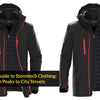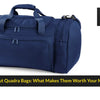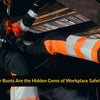PPE at Work Regulations (1992) - What to Know about This Law
- by Mike Johnson
PPE at Work Regulations (1992) - What to Know
The Personal Protective Equipment at Work Regulations 1992 (amended in 2002) is a key piece of health and safety legislation in the United Kingdom.
The Regulations require employers to provide suitable personal protective equipment (PPE) free of charge to employees who may be exposed to risks at work. Employers must also ensure that PPE is used correctly and properly maintained.
The Regulations apply to all types of PPE, including gloves, eye and face protection, hearing protection, respiratory protective equipment and fall arrest equipment.
The PPE Regulations are supplemented by the Provision and Use of Work Equipment Regulations 1998 (as amended in 2002), which place additional duties on employers concerning the maintenance and use of work equipment.
Here’s some important information about this rule:
How Employees Should Be Protected (According to Hierarchy)
PPE may be the topic in this article, but every business should know it should be the last resort for employee protection. When other methods of controlling risks to health and safety, such as engineering controls and safe systems of work, have been considered and prioritised, then comes PPE.
Here's how it should be prioritised:
- Elimination: Remove the hazard at the source by replacing the toxic chemical with a safer one.
- Substitution: Replace the hazard with a less toxic chemical.
- Engineering Controls: Isolate people from the hazard with physical barriers or ventilation.
- Administrative Controls: Change how people work to minimise exposure to the hazard.
- Personal Protective Equipment: Use personal protective equipment to protect people from hazards.
Samples of Personal Protective Equipment (PPE)
Lots of different types of Personal Protective Equipment (PPE) can be used to protect workers from hazards on the job. The type of PPE you need will depend on the dangers you are exposed to. Here are some examples of PPE that can be used to protect against common workplace hazards:
- Respirators or dust masks – to protect your lungs from airborne particles
- Earplugs or earmuffs – to protect your hearing from loud noise
- Safety glasses or goggles – to protect your eyes from flying debris or chemicals
- Hard hats – to protect your head from falling objects
- Steel-toe boots – to protect your feet from crushing injuries
- Reflective vests – to increase your visibility to others in low-light or dark conditions
- Gloves – to protect your hands from cuts or chemicals
- Aprons – to protect your clothing from stains or damage
Personal Protective Equipment at Work Regulations 1992: A Quick Look
The PPE at Work Regulations 1992 requires employers to:
- Make a suitable and sufficient assessment of the risks to the health and safety of their workers
- Identify any PPE that is necessary to protect their workers from the risks identified
- Provide the PPE identified
- Ensure that the PPE is used and used correctly
- Ensure that the PPE is maintained well and stored properly
The PPE at Work Regulations 1992 also requires employers to provide information, instruction and training to their workers on using PPE. It applies to all employers, the self-employed, manufacturers and suppliers of PPE. They place duties on employers to protect their employees by providing PPE and ensuring that it is used properly.
Failure to do so could result in injuries, diseases, or even fatalities, in addition to the legal action being taken against the employer.
The PPER was updated on April 6, 2022. It specified including limb (b) workers or those with casual employment set up in the bill protection.
Conclusion - PPE at Work Regulations (1992) - What to Know about This Law
Employers should ensure employee protection against potential risks in the workplace. That includes providing safety equipment, training employees on safety procedures, and maintaining a safe work environment. By taking these precautions, employers can help prevent accidents and injuries in the workplace.
Active Workwear is a UK-based distributor and retailer of head-to-toe protection workwear that works. We have provided high-quality branded clothing and workwear in the UK, Europe, and beyond for many years. Browse our products today.
- Posted in:
- Personal Protection Equipment






